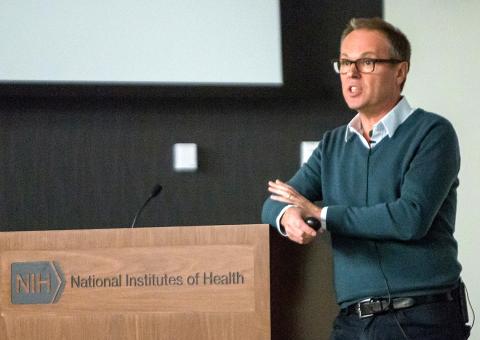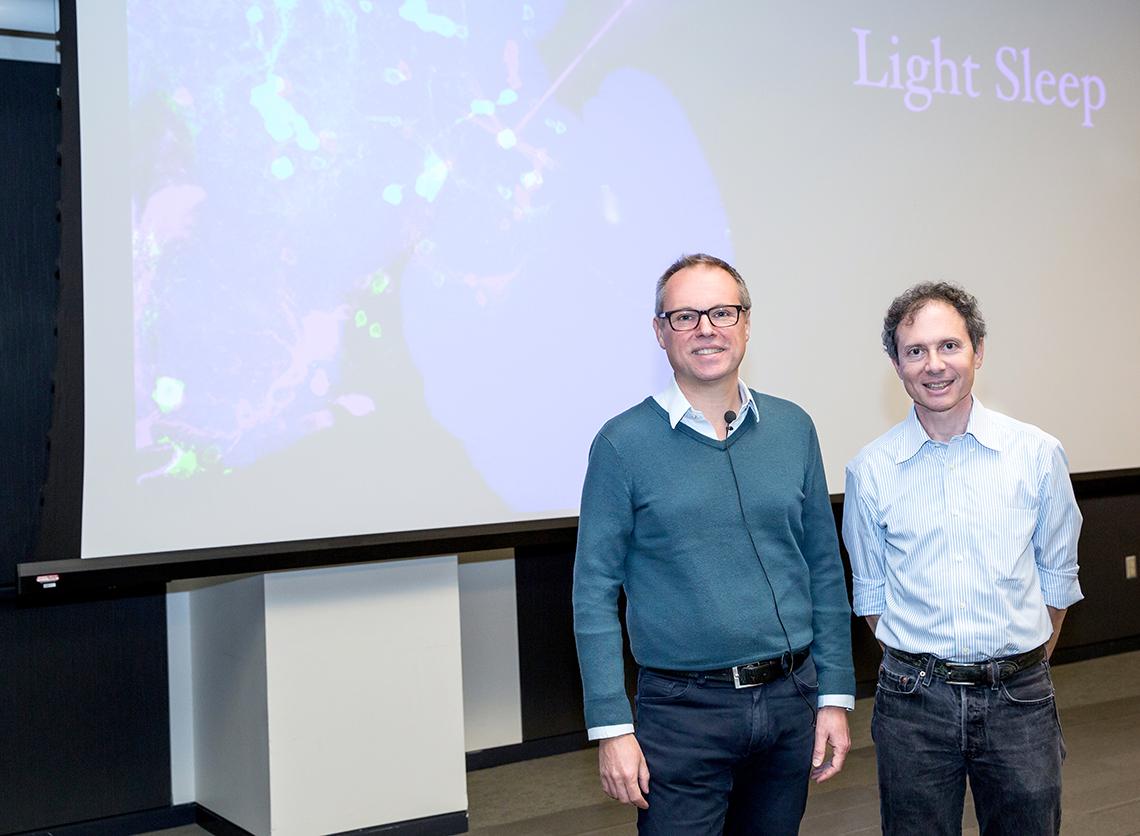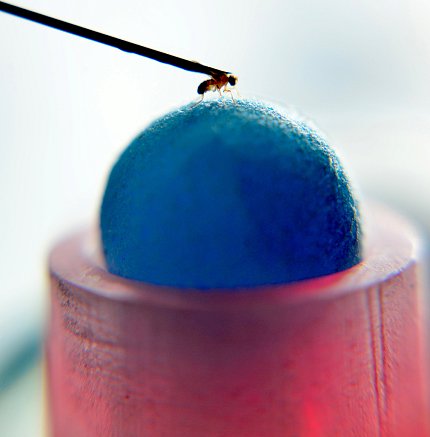Thermostat for Slumber?
Optogenetics Pioneer Reports Progress on Deciphering Sleep

Photo: Chia-Chi Charlie Chang
Researchers have wondered for decades why and how we fall asleep. To solve several age-old questions about slumber, investigators are using a relatively young scientific technique—optogenetics—to study fruit flies hooked to treadmills.
“Sleep is one of the great biological mysteries—each night we disconnect ourselves from the world for 7 or 8 hours, a state that leaves us vulnerable and unproductive,” explained Oxford’s Dr. Gero Miesenböck in an NIH Neuroscience Seminar Series lecture held recently. “Despite these risks and costs, we do not know what sleep is good for.”
Miesenböck pioneered optogenetics, a technique scientists can use to manipulate nerve cells—neurons—that have been genetically altered to be sensitive to light. In 2010, the technique was named “Method of the Year” by journals across scientific disciplines and Science magazine called it “Breakthrough of the Decade.”
The Waynflete professor of physiology and founding director of the Centre for Neural Circuits and Behaviour at Oxford University, Miesenböck illustrated the power of optogenetics in a talk titled “Light Sleep.”
“Most of us in this room have used techniques he designed,” said NICHD senior investigator Dr. Mark Stopfer, introducing the speaker. He said that in Miesenböck’s case, necessity must be the father of invention because he’s capable of developing the precise tools he needs to tackle large scientific puzzles.
“This ‘big question’ approach is what I like best about his work,” Stopfer said.

Photo: Chia-Chi Charlie Chang
At NIH to discuss “neural control of sleep as an illustration of what optogenetics has enabled us to do,” Miesenböck recalled his first goals for the method. Almost 20 years ago, he hoped technologies such as optogenetics would accomplish three things: First, “pinpoint the neural causes of behavior and cognition in a way that had previously been inaccessible.”
As a young scientist in training, he said he remembers one mantra being drilled into him daily—“reconstitution, reconstitution, reconstitution.” In order to understand a biological system, Miesenböck was taught, an investigator has “to be able to take it apart and put it back together.
“As a biochemist,” he explained, “that means you have to purify the enzymes that you think are responsible for a particular biological process and then reconstitute the process from the purified components.”
What would be the equivalent approach for a neuroscientist?
“Metaphorically speaking, you have to purify the electrical activity patterns that underpin our mental lives and play them back into the nervous system,” he said. “And if you can do that—and in this way recreate perception, action, memory and emotion—then you will have a credible claim that you really understand the causes of neural events.”
The other doors he hoped optogenetics would help open included the search for connections between key neurons and the dissection of mechanisms at work within specific systems.
All three goals were realized over the past two decades. In recent years, his team has turned its attention to another, more elusive quest.
Quoting renowned sleep research pioneer Dr. Allan Rechtschaffen, Miesenböck said, “‘If sleep did not have an absolutely fundamental purpose, then it would probably be the biggest mistake that evolution has ever made.’ But the question is, what is that purpose?”
Scientists know that two systems govern slumber—the circadian clock and what’s known as the “sleep homeostat.”
Studies of fruit flies back in 1971 gave the first clue of what determines a basic 24-hour wake/rest cycle that reigns over most organisms with nervous systems. This cycle anticipates predictable occurrences in the environment—darkness, for example—caused by Earth’s rotation and ensures we sleep when it suits our lifestyle best.
“Turns out, we know a lot about the mechanics of the circadian clock,” Miesenböck explained. Then, showing a blank screen, he quipped, “This slide summarizes much of what we know about the sleep homeostat.

Photo: Chia-Chi Charlie Chang
“The answer to the mystery of sleep,” he continued, “will probably be found in understanding the sleep homeostat [which] measures something—and we don’t know what that something is—that happens in our brains while we are awake. When that something reaches a threshold, we fall asleep.” The cycle resets itself as we rest.
“If we knew what that something is that accumulates or depletes to threshold,” Miesenböck said, “then we would have a very, very important piece in the puzzle of sleep.”
To try to understand why the brain turns itself off at night, the investigators returned to the simple nervous system of Drosophila, the fruit fly.
Each fly contains a couple dozen sleep-promoting neurons in a cell cluster that Dr. Jeff Donlea, a former member of Miesenböck’s team who is now at UCLA, identified when he was a graduate student in Dr. Paul Shaw’s group. Other animals, including humans, are thought to have neurons playing similar roles in inducing sleep.
“Optogenetics has shown us that these neurons exert a powerful influence on sleeping and waking,” The neurons have nothing to do with the circadian cycle, but convey the output of the sleep homeostat.

Photo: Miesenböck Group
Miesenböck and company devised an apparatus that lets them monitor fruit flies running on tiny treadmills or Styrofoam rollerballs. Because fruit flies aren’t known to walk in their sleep, he joked, the investigators surmise that when the rollerball stops spinning, the flies have fallen asleep.
The scientists were able to put the flies to sleep optogenetically by stimulating the sleep-inducing cells with a short burst of light. Reacting to the optical signal, the neurons ramp up their work and the flies go to sleep.
Over time, the researchers learned to reverse the effect—also optogenetically—by signaling release of dopamine to the neurons, which short-circuits the sleep-inducing neurons’ electrical work and wakes the flies.
Miesenböck’s group had successfully deconstructed and rebuilt the brain’s process of slumber. They published their most recent findings about this on/off switch in 2016.
“What I’ve described is a mechanism that you’re familiar with, because you have it on the walls of your living room,” Miesenböck said.
Much like the thermostat that controls a room’s temperature, your brain has a sleep homeostat that regulates your shuteye.
